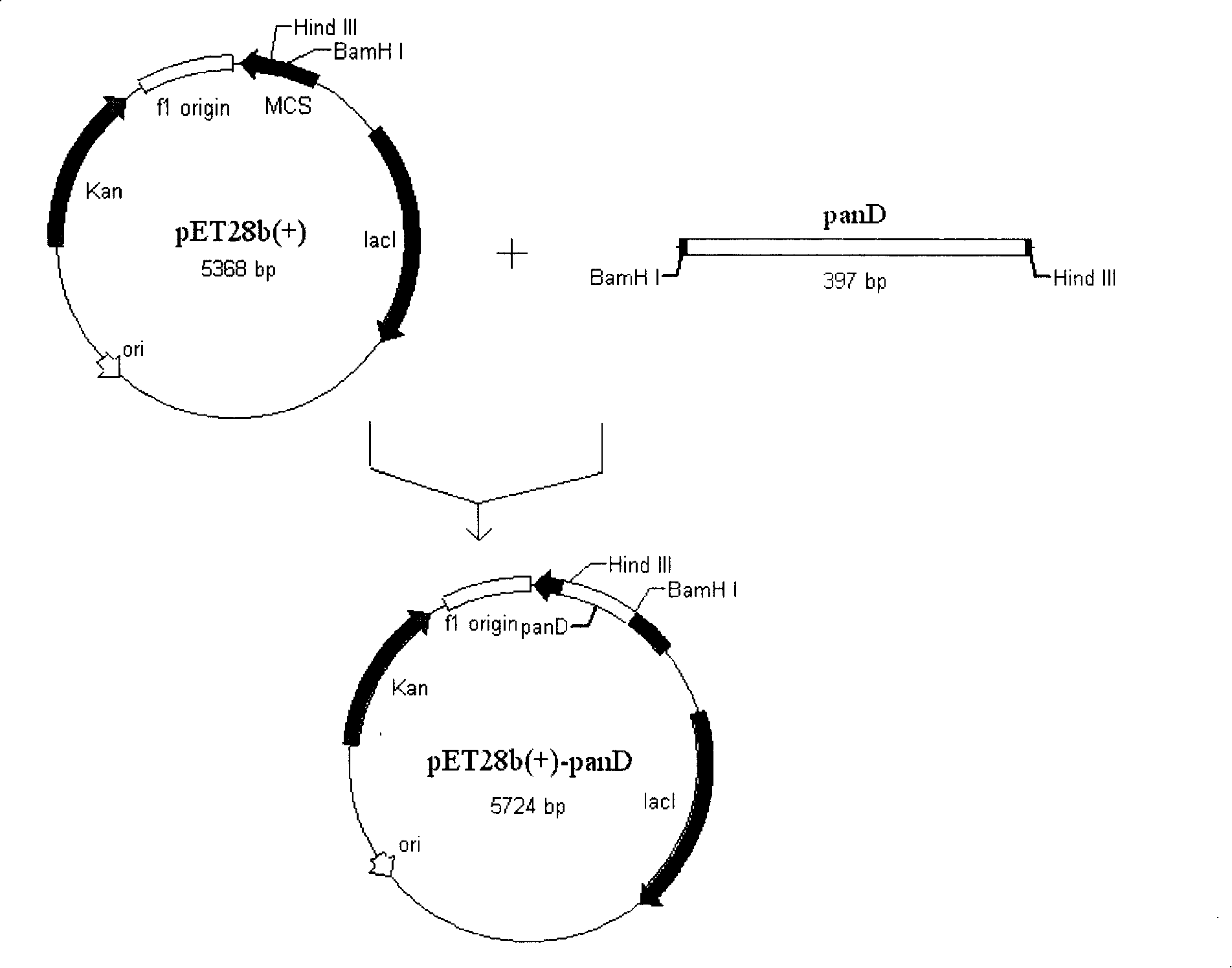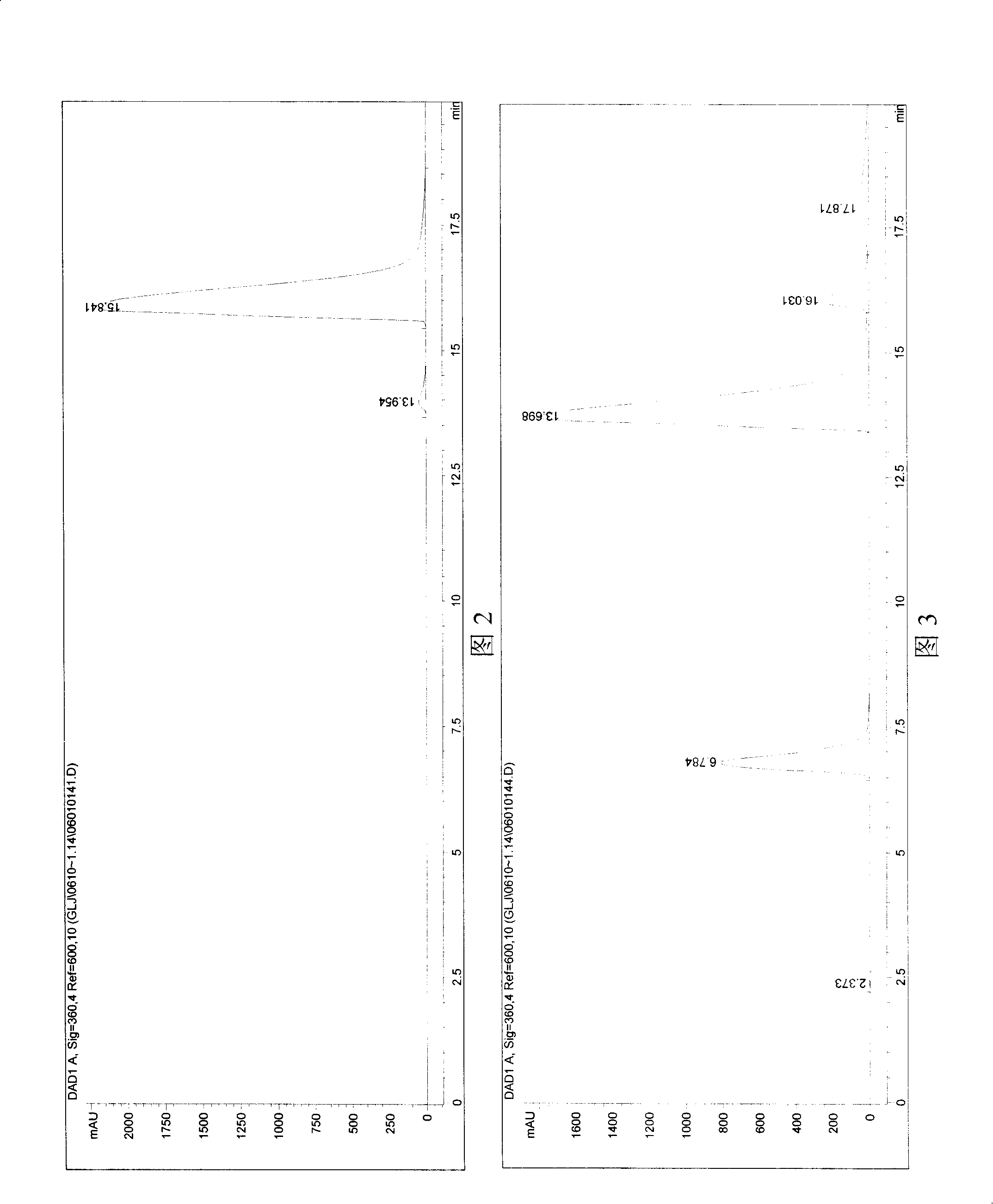Gene engineering bacterium for producing beta-alanine and its preparation and application
A technology of genetically engineered bacteria and alanine, applied in the field of preparation of β-alanine, can solve the problems such as the difficulty of screening strains with high activity of enzyme production
- Summary
- Abstract
- Description
- Claims
- Application Information
AI Technical Summary
Problems solved by technology
Method used
Image
Examples
Embodiment 1
[0036] Embodiment 1: Construction of high expression vector
[0037] step:
[0038] (1) According to the sequence design primer (forward primer: AAC GGATCC TATGATTCGCACGATGCTG, the underlined sequence is restriction enzyme BamH I cutting site; reverse primer: CCA AAGCTT AGCAACCTGTACCGGAATC, the underlined sequence is the cutting point of restriction enzyme Hind III), using PCR technology to amplify the sequence of the coding region; PCR reaction conditions: denaturation at 95°C for 3min; followed by 35 cycles, the parameters are 94°C, 1min; 60°C, 1min and 72°C, 45s; finally extend at 72°C for 5min.
[0039] (2) After the PCR product was recovered by gel, it was cloned into the corresponding site of pET28b(+) with the restriction enzyme BamH I / Hind III to form the high expression vector of panD gene pET28b(+)-panD. For the plasmid construction map, see figure 1 .
[0040] (3) Take 100 μl of Escherichia coli DH5α competent cells, put them on ice, gently suspend the cells e...
Embodiment 2
[0041] Embodiment 2: the acquisition of engineering bacteria
[0042] step:
[0043] (1) Take 100 μl Escherichia coli BL21(DE3) competent cells, put them on ice, and gently suspend the cells evenly after thawing completely.
[0044] (2) Take 5 μl of the plasmid pET28b(+)-panD obtained in Example 1, add it to the competent cells and mix gently. Place on ice for 30min.
[0045] (3) Heat shock in a water bath at 42°C for 90 seconds, and place on ice for 15-20 minutes.
[0046] (4) Add 400 μl of LB medium, culture at 37° C., shake at 200-250 r / min for 1 hour.
[0047] (5) Centrifuge at 4000 r / min for 5 min at room temperature, suck off 400 μl of the supernatant with a pipette tip, and suspend the cells with the remaining medium.
[0048] (6) Spread the transformed bacteria on LB (containing 30 μg / mL kanamycin) plates.
[0049] (7) Place the plate in the forward direction at 37°C for 1 hour to absorb excess liquid, and then culture it upside down overnight. After the strains g...
Embodiment 3
[0050] Embodiment 3: comparative experiment of β-alanine synthesis ability
[0051] The genetically engineered bacteria obtained in Example 2 were cultured on LB medium for 16-24 hours, then inserted into LB liquid medium containing 30 μg / mL of kanamycin, and cultured overnight at 37° C. and 200 r / min on a shaking table. Then transfer to the same LB liquid medium with 1% inoculum size, fill 250ml with 30ml LB liquid medium, culture at 37°C, 200r / min shaker until OD 600 When it is about 0.4 to 1.0, add inducer (IPTG final concentration is 0.4mmol / L or add lactose to final concentration is 8g / L), 30℃, 200r / min shaker culture for 12~20h, then put in 37℃, Cultivate on a shaker at 200r / min for 8h. Centrifuge at 4500r / min for 10min at 4°C, collect the cells, wash twice with 10mL sterile water, and finally add 5mL of 0.2mol / L L-asp (adjust the pH to 7.0 with NaOH), transform at 37°C and 200r / min 2d. The transformation solution was centrifuged at 4500r / min for 10min to obtain the s...
PUM
 Login to View More
Login to View More Abstract
Description
Claims
Application Information
 Login to View More
Login to View More - R&D
- Intellectual Property
- Life Sciences
- Materials
- Tech Scout
- Unparalleled Data Quality
- Higher Quality Content
- 60% Fewer Hallucinations
Browse by: Latest US Patents, China's latest patents, Technical Efficacy Thesaurus, Application Domain, Technology Topic, Popular Technical Reports.
© 2025 PatSnap. All rights reserved.Legal|Privacy policy|Modern Slavery Act Transparency Statement|Sitemap|About US| Contact US: help@patsnap.com


